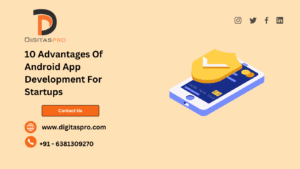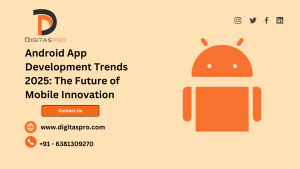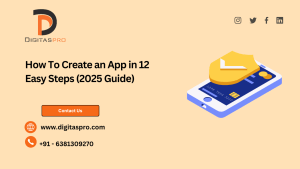Introduction — Why Android Development in 2025 Matters
Android continues to dominate the global smartphone market in 2025, powering billions of devices across phones, wearables, TVs, foldables, and even cars. For entrepreneurs, enterprises, and startups alike, building a successful Android app remains a powerful way to reach customers, drive revenue, and create digital impact.
Yet the landscape is shifting. Kotlin is now the default language. Jetpack Compose is the modern UI toolkit. AI, machine learning, and edge computing are no longer experimental but expected. Security, privacy, and accessibility are non-negotiable.
This complete Android development guide for 2025 will take you step by step — from idea to launch — so you can understand not just the how but the why behind modern Android apps. Whether you’re a startup founder, product manager, or developer, this playbook gives you clarity and direction for building world-class apps.
Step 1: Defining the Idea
Every successful app starts with a validated idea. In 2025, idea validation involves more than brainstorming — it’s about data, trends, and user needs.
Checklist for idea validation:
- Solve a real pain point (use surveys, forums, and market research tools).
- Study competitors: what do they lack?
- Define your target audience personas.
- Evaluate monetization strategies: subscription, ads, freemium, in-app purchases.
- Test with low-fidelity prototypes before investing heavily.
Step 2: Market Research and Planning
In 2025, the app economy is crowded — but niches still exist. Success depends on how well you align product vision with market needs.
Market research essentials:
- Analyze Google Play trends.
- Use ASO (App Store Optimization) insights early.
- Identify regulatory requirements (GDPR, COPPA, HIPAA depending on sector).
- Define KPIs: DAU (Daily Active Users), retention, conversion, and ARPU (Average Revenue Per User).
Project planning:
- Define a roadmap with milestones.
- Choose agile methodologies (Scrum, Kanban).
- Assign roles: developers, designers, QA, product managers.
Step 3: Choosing the Right Tech Stack
The Android ecosystem has matured. In 2025, the recommended stack looks like this:
- Language: Kotlin (with Java for legacy projects).
- UI Framework: Jetpack Compose (with interoperability for XML).
- Architecture: MVVM or Clean Architecture with modularization.
- Async & Concurrency: Kotlin Coroutines + Flow.
- Data Layer: Room, DataStore, Retrofit/Ktor for networking.
- Dependency Injection: Hilt.
- Testing: JUnit, Espresso, Compose testing framework.
- DevOps/CI/CD: GitHub Actions, Bitrise, or GitLab CI.
- Observability: Firebase Crashlytics, Sentry, OpenTelemetry.
Step 4: Designing the User Experience
Great design equals retention. In 2025, users expect intuitive, personalized, and accessible experiences.
Modern design practices:
- Material Design 3 (Material You) for consistent UI.
- Adaptive layouts for foldables and wearables.
- Accessibility-first (TalkBack, large fonts, color contrast).
- Motion and micro-interactions (Compose animations).
- AI-driven personalization (recommendations, smart shortcuts).
Step 5: Development Workflow
The Android app development lifecycle should balance speed, quality, and maintainability.
Workflow outline:
- Setup repository with Git + CI/CD pipelines.
- Implement app modules: authentication, database, networking.
- Integrate APIs (REST, GraphQL).
- Implement offline-first strategies (caching, sync).
- Secure the app: encrypted storage, secure networking, biometric authentication.
- Continuously test features with automated test suites.
Step 6: Integrating Emerging Technologies
In 2025, successful apps integrate cutting-edge features without overcomplicating the core value.
- AI & ML: TensorFlow Lite, Firebase ML Kit for image recognition, NLP, and recommendations.
- AR/VR: ARCore for immersive experiences.
- Wearables: Companion apps for smartwatches and fitness devices.
- IoT: MQTT and WebSocket integration for connected devices.
- Voice Interfaces: Google Assistant integration.
Step 7: Testing and Quality Assurance
Testing ensures stability and user trust.
Types of testing in 2025:
- Unit Testing (JUnit)
- Integration Testing (Espresso, Compose Testing)
- UI/UX Testing (manual + automated tools)
- Performance Testing (profilers, Firebase Test Lab)
- Security Testing (penetration testing, OWASP compliance)
Step 8: Deployment & Launch
Launching involves more than uploading your APK to Google Play.
Pre-launch checklist:
- Optimize app size with App Bundles (AAB).
- Configure Play Console for staged rollouts.
- Conduct beta testing with closed groups.
- ASO: optimize titles, keywords, and screenshots.
- Set up crash reporting and analytics before release.
Post-launch activities:
- Monitor crash rates and ANRs (Application Not Responding errors).
- Analyze KPIs with Firebase Analytics.
- Collect user feedback via in-app surveys.
Step 9: Marketing and Growth
Building is half the journey. Marketing ensures adoption.
Growth strategies:
- Leverage pre-launch buzz on social media.
- Collaborate with influencers.
- Paid user acquisition campaigns.
- Retention strategies: push notifications, loyalty programs, referral bonuses.
- Continuous ASO optimization.
Step 10: Maintenance and Scaling
Apps are never “done.” Maintenance is ongoing.
Post-launch responsibilities:
- Regular updates for OS changes and security patches.
- Performance tuning (startup time, memory use).
- Scaling backend systems to handle growing traffic.
- Introducing new features incrementally.
- Monitoring reviews and user satisfaction.
Common Pitfalls to Avoid
- Overloading the app with features at MVP stage.
- Ignoring security and privacy compliance.
- Failing to design for multiple form factors.
- Neglecting testing and observability.
- Delayed post-launch support.
The Future of Android Apps Beyond 2025
- AI-first apps: personalization and automation built-in.
- Decentralized apps (dApps): blockchain-enabled identity and payments.
- Edge computing integration: faster, offline-capable features.
- Ultra-immersive UI: AR + VR mainstream adoption.
- Eco-conscious development: battery-efficient, resource-light apps.
Why DigitasPro Technologies
At DigitasPro Technologies, we guide businesses through the entire Android development journey — from idea validation to deployment and scaling. Our expertise in Kotlin, Jetpack Compose, ML/AI, and secure DevOps pipelines ensures that your app is not just built, but built to last.
Whether you need a discovery workshop, a development partner, or a full-stack product launch, we provide a strategy-first, execution-focused approach.
Conclusion — From Idea to Impact
The complete Android application development lifecycle in 2025 demands clarity, discipline, and innovation. By validating ideas, choosing the right stack, adopting modern practices, and scaling responsibly, you can transform a concept into a successful app.
With the right expertise — and a partner like DigitasPro Technologies — your idea can evolve from a sketch on paper to a global product in millions of hands.



